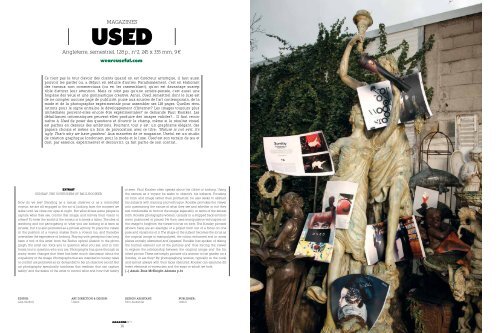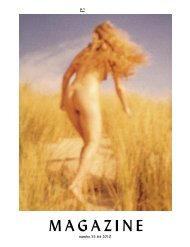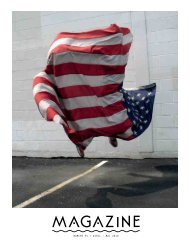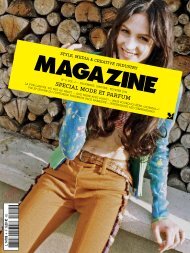SPECIAL MODE ET MEDIA - Magazine
SPECIAL MODE ET MEDIA - Magazine
SPECIAL MODE ET MEDIA - Magazine
You also want an ePaper? Increase the reach of your titles
YUMPU automatically turns print PDFs into web optimized ePapers that Google loves.
EDITOR :<br />
Alex Geoffrey<br />
MAGAZINES<br />
USED<br />
Angleterre, semestriel, 128 p., no 2, 245 x 335 mm, 9 €<br />
EXTRAIT<br />
SUNDAY, THE VOYEURISM OF PAUL KOOIKER<br />
How do we see? Standing as a casual observer or as a committed<br />
voyeur, we are all engaged in the art of looking from the moment we<br />
wake until we close our eyes at night. But what drives some people to<br />
capture what they see, control that image, and convey their vision to<br />
others? To enter the world of the voyeur is to break a taboo. The idea of<br />
watching and not participating in what you are looking at is seen as<br />
sinister, but it is also perceived as a private activity. To place the viewer<br />
in the position of a voyeur makes them a voyeur too, and therefore<br />
intensifies the experience of looking. Playing with perception has long<br />
been a tool of the artist: from the Escher optical illusion to the photograph,<br />
the artist can force you to question what you see, and in turn<br />
forces you to question who you are. Photography has gone through so<br />
many recent changes that there has been much discussion about the<br />
culpability of the image. Photographs that are intended to convey news<br />
or conflict are perceived as (or demanded to be) an objective record. But<br />
art photography specifically combines this medium that can capture<br />
‘reality’ and the desire of the artist to control what and how that reality<br />
ART DIRECTION & DESIGN :<br />
Useful<br />
weareuseful.com<br />
Ce n’est pas le tout d’avoir des clients quand on est directeur artistique, il faut aussi<br />
pouvoir les garder ou, à défaut, en séduire d’autres. Paradoxalement, c’est en élaborant<br />
des travaux non commerciaux (ou en les rassemblant), qu’on est davantage susceptible<br />
d’attirer leur attention. Mais ce n’est pas qu’une arrière-pensée, c’est aussi une<br />
hygiène des yeux et une gymnastique créative. Ainsi, Used, semestriel dont le luxe est<br />
de ne compter aucune page de publicité, puise aux sources de l’art contemporain, de la<br />
mode et de la photographie expérimentale pour assembler ses 128 pages. Quelles révolutions<br />
pour le signe entraîne le développement d’Internet ? Les images toujours plus<br />
immédiates peuvent-elles encore être expérimentales ? se demande Paul Kooiker. Les<br />
défaillances informatiques peuvent-elles produire des images valides ?… Il faut reconnaître<br />
à Used de poser des questions et d’ouvrir le champ, même si le résultat visuel<br />
est parfois en dessous des ambitions. Pourtant, tout y est : un graphisme élégant, des<br />
papiers choisis et même un brin de provocation avec ce titre : “Nature is not evil, it’s<br />
ugly. That’s why we have gardens”. Aux manettes de ce magazine, Useful est un studio<br />
de création graphique londonien pour la mode et le luxe. Used est son terrain de jeu et<br />
doit, par essence, expérimenter et découvrir ; ça fait partie de son contrat…<br />
MAGAZINE N O 7<br />
14<br />
is seen. Paul Kooiker often speaks about the cliché of looking. Using<br />
the camera as a voyeur he seeks to objectify his subjects. Focusing<br />
on form and image rather than portraiture, he also seeks to abstract<br />
his subjects with framing and technique. Kooiker provokes the viewer<br />
into questioning the nature of what they see and whether or not they<br />
feel comfortable in front of the image, especially in terms of the female<br />
form. Kooiker photographs women, usually in a stripped back environment,<br />
positioned or placed. He then uses manipulative techniques on<br />
the image to heighten the viewer’s focus on form. The Sunday pictures<br />
(shown here) are an example of a project born out of a focus on one<br />
pose and variations of it. The shape of the subject becomes the focus as<br />
the original image is manipulated, the colour enhanced and in some<br />
places entirely abstracted and repeated. Kooiker has spoken of taking<br />
the human element out of the pictures and thus forcing the viewer<br />
to explore the relationship between the original image and the finished<br />
picture. These are simply pictures of a woman in her garden on a<br />
Sunday, or are they? By photographing women, typically in the nude<br />
and almost always with their faces obscured, Kooiker can examine different<br />
elements of voyeurism and the ways in which we look.<br />
[…] Amah-Rose McKnight-Abrams p. 34<br />
DESIGN ASSISTANT :<br />
John Alexander<br />
PUBLISHER :<br />
Useful











